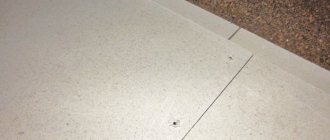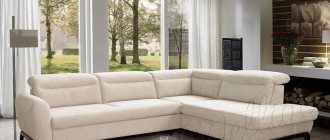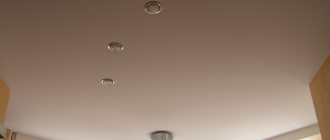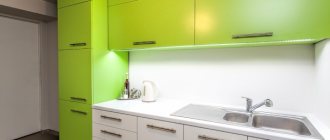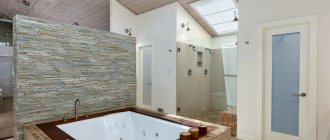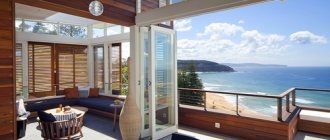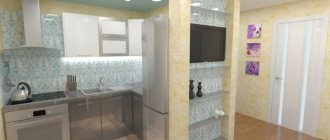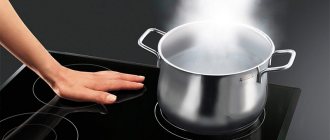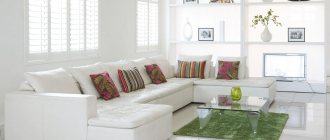Pros and cons of cork flooring
Soundproofing
Cork has a honeycomb structure with airtight, dense membranes. Thanks to this, acoustic and impact noise is completely or partially muffled (depending on the thickness of the coating). When walking in shoes, we practically do not hear the hum characteristic, for example, of laminate flooring.
In addition, cork flooring muffles sounds coming from outside . For example, neighbors below complain about the noise of footsteps or other physical actions - the flooring completely dampens such sounds. Now there is no need to create sound insulation by laying thick layers of insulators to rid neighbors of noise (substrates reduce the height of openings and ceilings). All you have to do is lay cork floors and this problem will be solved!
Water resistance
Cork flooring is 100% moisture-resistant and waterproof , provided that the technical requirements for installation are met. When installing the locking plug, it is recommended to apply moisture-resistant silicone sealant to the end protrusions of the locks for connection - to protect the HDF board from moisture. The cork itself is not afraid of moisture.
Adhesive cork floors, when installed correctly, are 100% moisture-proof without sealant treatment! The floor covering is even protected from floods : if the sink or washing machine leaks, water immediately covers the entire area.
Benefit for health
When walking the load is removed from the spine ; shock loads are much less compared to, for example, ceramic tiles. In addition, the cork will make walking easier for those who suffer from flat feet .
Elastic and moderately soft floor
Floor coverings are also installed in gyms or health rooms, as they provide good shock absorption and noise suppression . The cork is restored after point loads, the surface is soft: your favorite cup will not break, and if it falls, it will not damage the floor!
Natural warmth
Cork accepts room temperature and maintains it due to its low thermal conductivity. Where there are cork floors, do not wear slippers and do not install heated floors!
Natural origin of the material
Coatings made from cork oak bark do not contain synthetic additives: stabilizers are simply not required. Thanks to this, toxic emissions are eliminated, including during combustion.
Hypoallergenic
People suffering from allergic diseases can be absolutely calm: cork does not cause irritating ions that affect human allergic receptors!
Scratch protection
Pets do not react to varnished material , which means you don’t have to worry about the integrity of the cork floor if there is a cat or dog in the house.
Comfortable indoor microclimate
And of course the natural microclimate! The comfort and atmosphere of natural material will complement any room: bedroom or office, playroom or children's room, living room, kitchen, bathroom, dining room.
Cons of cork coverings
- Price. The flooring is not economy class.
- Laying. Laying flooring with your own hands, especially the adhesive type, is problematic: entrust the installation to professionals.
- Preparing the base. A perfectly level, dry, clean and stable screed is required.
Cork floor - expert review
We purchased interlocking cork flooring for the children's room. We were guided by my experience in styling, the natural warmth and softness of the material. In this regard, cork is truly an excellent material.
It so happened that while we were going on vacation, we were left to stay in a relative’s apartment. Upon arrival, we found several damaged boards. The relatives used a work stool without a plastic plug, which was left over after the renovation. We purchased additional packaging of the coating and replaced the damaged areas. What is better laminate or parquet board?
A few years after replacing the old sofa with a new one, we saw a frightening picture. No, of course, we had noticed up to this point that the legs of the sofa leave marks, but we didn’t attach much importance to it. Nevertheless, the main area of damage was covered.
The depressing appearance of the damaged cork finally convinced my wife that it was in vain to listen to me and lay a cork floor. The cork itself was not pressed through, but the coating was damaged by knocked down and crumpled veneer. You heard right, in cork the top layer is covered with veneer. I suggested fixing the problem in a simple way: reinstalling the cork. As a result of re-flooring, I removed the damaged panels to the last rows under the place of the future sofa. And we got the floor like new. Here it is, plus a glueless locking connection.
Another 3 years passed, while my son was in the village and I had a few free days, we decided to replace the cork floor with laminate. An old problem resurfaced - dark marks were left on the floor from the furniture legs. During dismantling, I carefully examined all the boards for further possible use or sale through Avito. For this reason, I sorted the flooring and this is what I noticed after 6 years of use.
Types of cork flooring
Lock plug
➤ Select cork laminate with glueless installation in the catalog.
Interlocking cork flooring is laid in the same way as conventional laminate flooring. There is a double-sided lock with which the planks are connected. Castle boards have a thickness of 10-11 mm. Thanks to the multilayer structure, less thorough preparation of the base is required , but due to the HDF middle layer, the flooring somewhat loses its moisture resistance.
✦ Typical structure:
- The final coating is a protective varnish - applied at the factory.
- The top layer is 3 mm cork.
- The supporting base is a dense HDF board into which locks are embedded.
- The bottom layer is 1 mm cork.
Glue plug
➤ Select adhesive cork flooring, contact adhesive, polyurethane varnish in the catalog.
Waterproof adhesive flooring is a solid mass of pressed cork with a top layer of natural veneer (with various placements of fragments) or with photo printing. The plates are glued directly to the base (screed, plywood, self-leveling floor). Thickness 4 mm or 6 mm - depending on the manufacturer. After installation, 2-3 layers of protective varnish are required.
Types of natural floor corks
, their distribution according to the method of installation becomes important . The following types of coatings are distinguished in this direction:
- Adhesive type. Cork elements can be in the form of tiles or panels of a monolithic or layered structure. The main feature is that they are attached to the base of the floor using glue. This method allows for shaped installation and installation in hard-to-reach areas (for example, under a heating radiator). The main disadvantage is the rather high cost of special glue and its reduced water resistance.
- Castle type. Cork laminate usually has a special profile on the edges that provides interlocking connections between elements of adjacent rows. This type of installation does not require glue, because... The lock securely fastens all the tiles into a single system. This method greatly simplifies the installation of the coating, while being cheaper, despite the higher cost of the panels themselves (due to the elimination of the adhesive composition). The main disadvantage is that the elements are connected only in a certain direction, which does not make it possible to provide decorative installation. In addition, difficulties arise in problem areas of the floor.
- Substrate. In addition to natural cork coverings, roll materials made from technical cork are also available for sale. The content of the natural component in them is significantly lower, which makes it possible to significantly reduce the cost and be produced in long strips. The primary use is a substrate with an insulating effect.
When using cork flooring, a variety of design solutions can be achieved. In this matter, first of all, attention is paid to the color of the cork. The color palette is quite wide, and therefore the choice of coating should be made taking into account the design of the entire room in the house.
If you have light-colored furniture, preference can be given to cork with a white background. It should be borne in mind that beige and cream colors can visually expand the space.
We recommend: The best design flooring options for a private home. Floor color and combination of different solutions
Another important indicator is texture . The surface of the cork can imitate various materials. The most popular imitation wood is birch, alder, oak, walnut, rosewood , etc. You can choose a coating for sandstone, natural stone, marble, pebble, shell rock.
In modern models, photo printing is used, which allows you to create an artistic photo parquet from cork elements on the floor.
Cost formation
The price depends on the design:
- Natural – natural color of cork coated with wear-resistant varnish.
- Painted - tinted to a specific color, the texture is preserved.
- Photo printing - any decor is applied directly to the cork layer: imitation of wood, natural stone, abstractions, thematic designs. Select a cork with photo printing in the catalog.
In addition, the cost depends on the design . Let's look at Corkstyle as an example: Tigre decor is more expensive than Madeira, and Madeira, in turn, is more expensive than Mono. All the models presented in the example are made according to different designs: some are difficult to manufacture, so their prices are higher. But in terms of operational characteristics, the models are absolutely identical .

